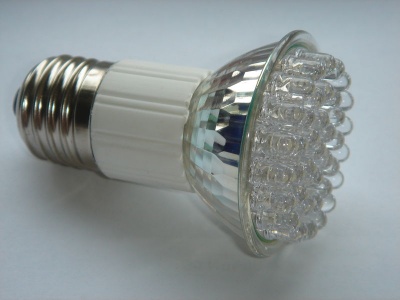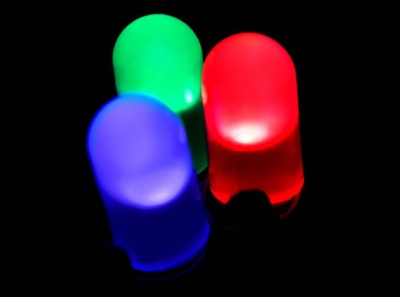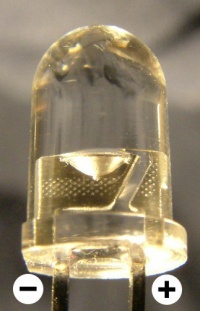Difference between revisions of "LED Lighting"
(mains ones too) |
|||
| Line 73: | Line 73: | ||
LEDs are famed for very long lives of 50,000 hours and up. But this only applies to LEDs conservatively run, such as LED indicators. When much greater output for lighting is wanted, run currents must be higher, and lamp life falls severely. LED lighting can not be expected to have anything like the same longevity. | LEDs are famed for very long lives of 50,000 hours and up. But this only applies to LEDs conservatively run, such as LED indicators. When much greater output for lighting is wanted, run currents must be higher, and lamp life falls severely. LED lighting can not be expected to have anything like the same longevity. | ||
| + | |||
| + | ==Mains Lamps== | ||
| + | Mains LED lamps are not equivalent replacements for filament lamps, and typically come with the following properties: | ||
| + | * much lower light output than the filament lamp they replace | ||
| + | * lower power | ||
| + | * much lower CRI | ||
| + | * limited life times | ||
| + | * built in ballast fries if used on an MSW invertor | ||
| + | * white LEDs degrade significantly in use | ||
==See Also== | ==See Also== | ||
Revision as of 10:06, 15 February 2008
LEDs are miniature very low power solid state light sources sometimes used for low light output applications. They are commonly available in sizes from 2mm upwards. They have niche applications, but are not in a position to take over from other forms of lighting for general lighting service.
There are also LED lamps intended to directly replace mains filament lamps. These contain many miniature LEDs plus built in ballast, and are available in various colours, including white.
LED vs Fluorescent
Disadvantages:
- Even the highest efficacy LEDs have not reached the efficacies of the highest efficacy fluorescent lights.
- The lowest cost lower efficacy LEDs have not reached the efficacies of low cost linear fl or CFL.
- LEDs' upfront cost is much higher for anything beyond extremely small light outputs.
- LED light quality is poor compared to fluorescent.
- LEDs are not available in powers comparable to fl lights
Advantages:
- Some, but far from all, LEDs have much longer lives than fl tubes. Many have shorter lives
- LEDs are more mechanically robust
- LEDs in very low powers are much smaller than fls
- The lowest power LEDs (fractional watt) are available in sizes 2mm to 10mm.
Things may change, as LED performance is getting better year by year. But they have not got there yet, despite the hype.
Colour
LEDs are available producing single monochromatic colours or in white. Colour LEDs are considerably cheaper than whites and suffer less from deterioration. One LED colour deteriorates severely, and is thus unsuitable for lighting, this is pink LEDs.
Ultrabright coloured LEDs are commonly available in 2mm to 20mm sizes rated 40mW - 80mW for in the region of 20p-30p per LED. These LEDs are typically rated in the region of 2-4v 20mA, and must be supplied by a current controlled source.
These miniature LEDs are suitable for very low level intense colour mood lighting (many LEDs are needed to get much light output). Their tiny size, minimal power consumption and safe low voltage makes them fittable almost anywhere. Their very low output makes them mostly used for dim but strongly coloured glows and nightlighting.
They may be used with glass shelving to give the glass edges a coloured glow, or to light glass objects.
Bicolour LEDs contain 2 dice of different colours back to back. These may be switched between the 2 colours, or may be faded from one colour to another at will by driving with ac and controlling the current in each half cycle separately.
Ballasts
LEDs themselves can not simply be connected to a power supply, they need external current control. This is built in to LED lamps intended to directly replace other lamp types, so these can simply be plugged in and used. However miniature LEDs are just the LEDs, so need a little external electronics.
The most common option is to use parallel series strings, with each series string having its own current limiting resistor. For example:
LED1 LED2 LED3 LED4 R1 +----|>|-----|>|-----|>|-----|>|---/\/\---+ | | +----|>|-----|>|-----|>|-----|>|---/\/\---+ | | +----|>|-----|>|-----|>|-----|>|---/\/\---+ | | +----|>|-----|>|-----|>|-----|>|---/\/\---+ | | | | o +12v 0v o
How close to the supply voltage your LED string voltage should add up to depends on how stable the supply voltage is, and how much brightness variation is acceptable.
LEDs are constant voltage devices, and will have the same V drop regardless of current. This then leaves the resistor in each string seeing voltage variations that are the same in absolute terms as the supply voltage variation, but much greater in percentage terms. Therefore any supply voltage variation causes several times the percentage of variation in light output.
For mains powered supplies, LEDs adding upto to 2/3 - 3/4 of the supply voltage should be fine. Variation is not usually then noticeable. When run off batteries, this would result in wide brightness variation, so a lower LED string voltage may be used.
Brightness variation can be avoided entirely with a stabilised supply if wished, but it is not usually necessary.
Polarity
LEDs must be connected with the correct polarity, as they only conduct one way, and they can only withstand a few volts in reverse.
Length of leads is not a reliable indicator of polarity, despite being often quoted as a method of determining it. The shape of the internal construction tells the polarity reliably.
Life
LEDs are famed for very long lives of 50,000 hours and up. But this only applies to LEDs conservatively run, such as LED indicators. When much greater output for lighting is wanted, run currents must be higher, and lamp life falls severely. LED lighting can not be expected to have anything like the same longevity.
Mains Lamps
Mains LED lamps are not equivalent replacements for filament lamps, and typically come with the following properties:
- much lower light output than the filament lamp they replace
- lower power
- much lower CRI
- limited life times
- built in ballast fries if used on an MSW invertor
- white LEDs degrade significantly in use



